What the heck we were doing in Nepal?! Plus what it was like to travel in Nepal during monsoon.
Our initial plans for Nepal sounded pretty badass: we would enter through the eastern tea hills, putter about in the Kathmandu valley as we sorted out visas, strap on our packs and hike over 5,000 meter plus passes, then our way through remote and offbeat Western Nepal to cross into Northern India.
What we actually did: drink a metric shit ton of coffee, twiddle our thumbs, and bond with working wifi (my love, I needed you).
So we went to Nepal… why?
Our venture into Nepal was ill-fated from the start: July is full-on monsoon season in the country, and the month with the highest levels of precipitation.
Heavy rains are the obvious downside, but more practical problems are the regular landslides and the clouds bringing the rain; in monsoon, the Himalayas are completely obscured by clouds most of the time! Nothing says “Nepal adventure” like not seeing any mountains, eh eh?
Check out this monsoon packing list for all the gear you need when traveling in Nepal during the monsoon!

Never fear, we did see some of them… for an hour or two in total. Score! (I think?)
So why did we visit Nepal at such a wretched time? Aside from being distracted by the awesome that is Northeast India and spending longer there than intended, we came with an ulterior motive: to apply for new Pakistan visas. We needed to send our passports all the way back to the Netherlands to do so, and that was only possible from Nepal, not India (where it’s illegal to send passports in or out of the country).
If you follow us on our Facebook or Instagram, you’ll know our visa quest did not go as expected. We thought it would take several days… and it turned out to take several weeks, thanks to Dutch customs seizing our passports for a time. Fun!
Since we had to be on call while waiting for our precious passports to return, that meant no getting lost in the mountains of Nepal. It was a bummer (especially since we’d already paid for trekking permits), but such is the unexpected nature of traveling. Besides, there are far worse places to be stuck than cushy tourist hotspots filled with comfort food and kickass coffee.

The tip of the Nepali iceberg
Since trekking was off the table, we put our noses to the grindstone more days than not, focusing on the blog and freelance work. Once our minds turned to mush, we turned to the streets, casually wandering but not actively exploring.
We don’t have any crazy stories or truly offbeat tips for you from Nepal, but that’s okay. Nepal is a popular country; it’s been written about by thousands of people a million times over, and there’s no lack of information available about it on the internet—a change from most of the other destinations we’ve visited in recent months!

The congested tourist neighborhood of Thamel in Kathmandu. And this is during the off season!
There’s nothing we can say that hasn’t been better said by someone else, so we’ll refrain from dishing out advice aside from one point: do come, Nepal is recovering from the earthquake, the country is safe, and the people need your tourism!
If you’re looking for tips on Nepal, we recommend the Lonely Planet Nepal guide. Its coverage of trekking routes is extensive, and it was updated after the 2015 earthquake.
Of course, it would be a shame not to share anything from our month there… and we know other people are curious as to how it is to travel during monsoon in Nepal. We sure were! Instead of trying to explain in words, why don’t we let our photos do the talking?

50+ photos of travel in Nepal during monsoon
The tea hills of Ilam
After crossing overland from India into Nepal, we headed up into the tea hills of Ilam. We can’t speak as to how busy it is during high season, but we were told it’s rarely visited by tourists compared to other destinations in Nepal. There’s your off the beaten track tip!

The hills surrounding Ilam are covered with tea! It’s exceptionally easy to escape the town and find a bit of peace and quiet in the greenery around, thanks to a million and one footpaths criss crossing the tea fields.
Why visit Ilam? Aside from the convenience of being close to the Indian border, tea from Ilam is widely regarded as the best tea produced in Nepal. We’re no tea aficionados (#coffee4life) but there was no denying the allure of tea fragrances in the air, and all the tea we had was excellent.


Unfortunately, most days the mountains were covered in clouds, and we were lost in fog. Here’s a more typical view of Ilam during monsoon!
[bscolumns class=”one_third one_third_first”]


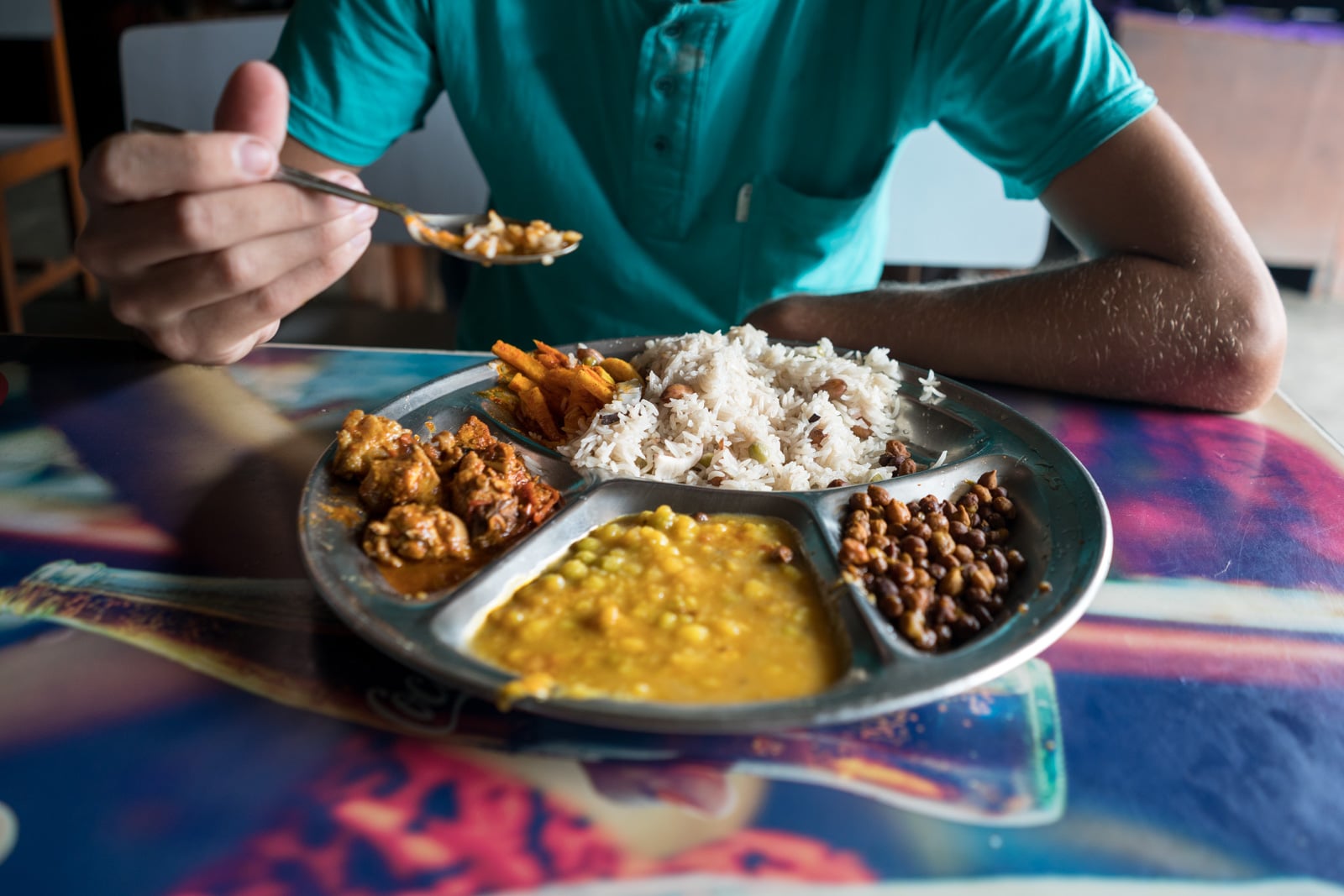
We whiled away the cloudy days sipping tea, reading, and trying out Nepali food! This meal, dal bhat, is found everywhere in the country, and usually includes rice, lentils, some vegetables… and whatever else is available! Most people tire of it quickly, but I fiend for rice—I could (and did) eat it all day errday.

We ran into these pack horses while trekking to Mai Pokhari lake, a holy place about 15km from Ilam. I’d share photos of the lake… but we don’t have any! It poured—and I mean poured—rain for hours right before we reached the lake. We were soaked beyond the bone, and it was way, way too wet to even think about taking a camera out. #monsoon
The dusty streets of Kathmandu
We took a bus to get from Ilam to Kathmandu, Nepal’s capital… but it was not as easy as it sounds.
The bus ride from Ilam to Kathmandu is supposed to take about 14 hours. Monsoon, however, is another story.

Epic views on the road from Ilam to Kathmandu
During monsoon, landslides are incredibly common. Many of Nepal’s roads are already in poor condition, and when a landslide occurs, traffic can stop for hours while people wait for someone to come and clear out the rubble.
Our 14-hour bus ride ended up taking 27 hours; a long, sweaty, and generally unpleasant ordeal. (Our feet also looked like balloons by the time we emerged like sticky swamp monsters from the deep in Kathmandu, an amusing first for us!)
Luckily, despite thick clouds of dust from rampant construction, Kathmandu proved to be a fascinating city to get lost in.

Nepal’s streets can be a struggle at times, but there’s more than enough going on to keep you distracted from it!

… like these tiny Buddhist shrines found all throughout the city! Though clouds may make for flat photography during the monsoon days, nights in Kathmandu are certainly atmospheric enough to make up for the daytime drab.
[bscolumns class=”one_third one_third_first”]



Night falls on the massive Hindu Pashupatinath temple on the outskirts of Kathmandu. The UNESCO temple complex feels a bit like Varanasi, India—colorful pilgrims, a holy river, burning funeral pyres.

Every evening around 18:00, visitors can watch and participate in the Bagmati Aarti, a ritual where the light of oil lamps is offered up to the gods by the priests of the temple.
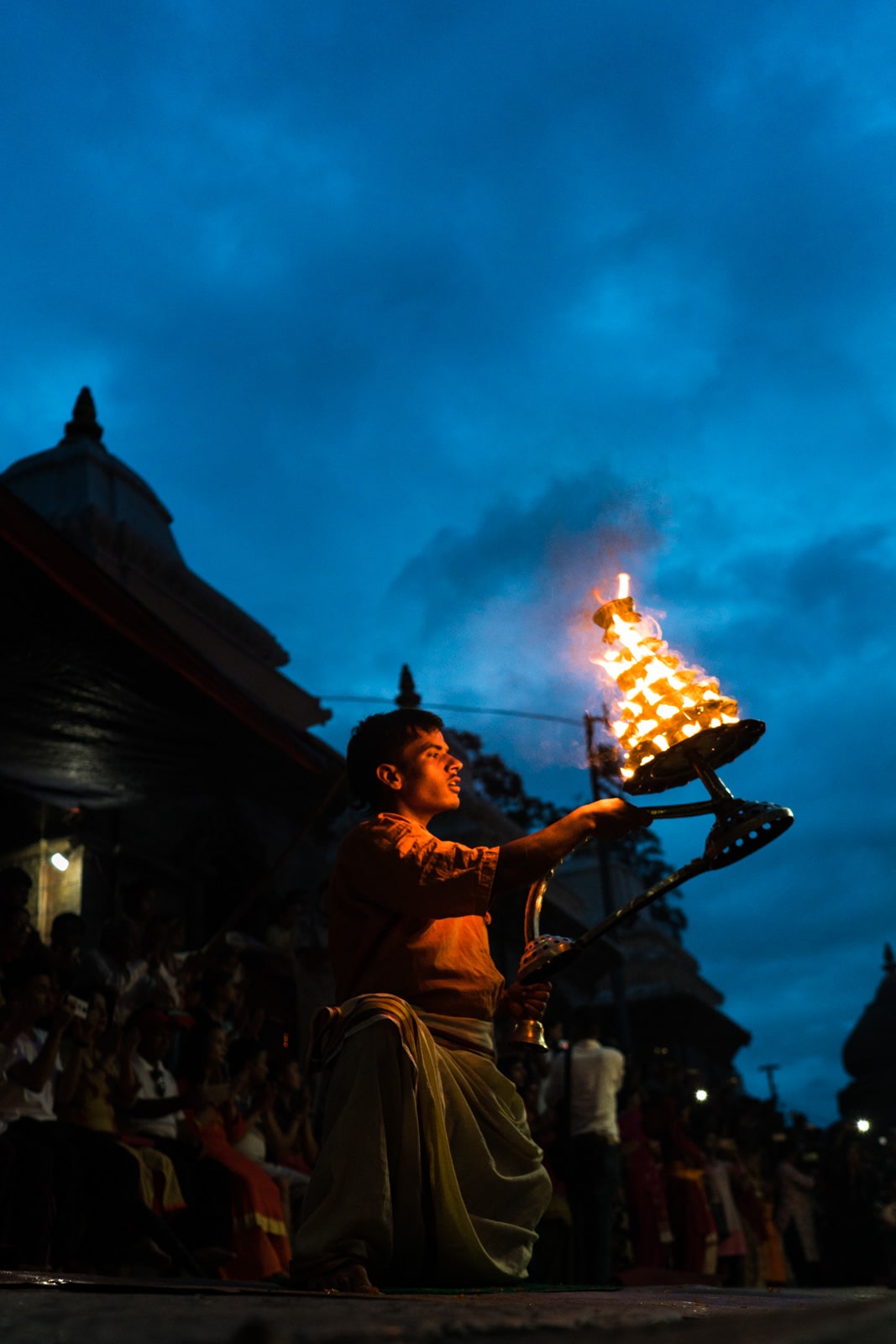

Hundreds of temples are scattered throughout Kathmandu… and there are even more places with the “temple” moniker. Swayambhunath is a towering Buddhist stupa overlooking Kathmandu more commonly known as…
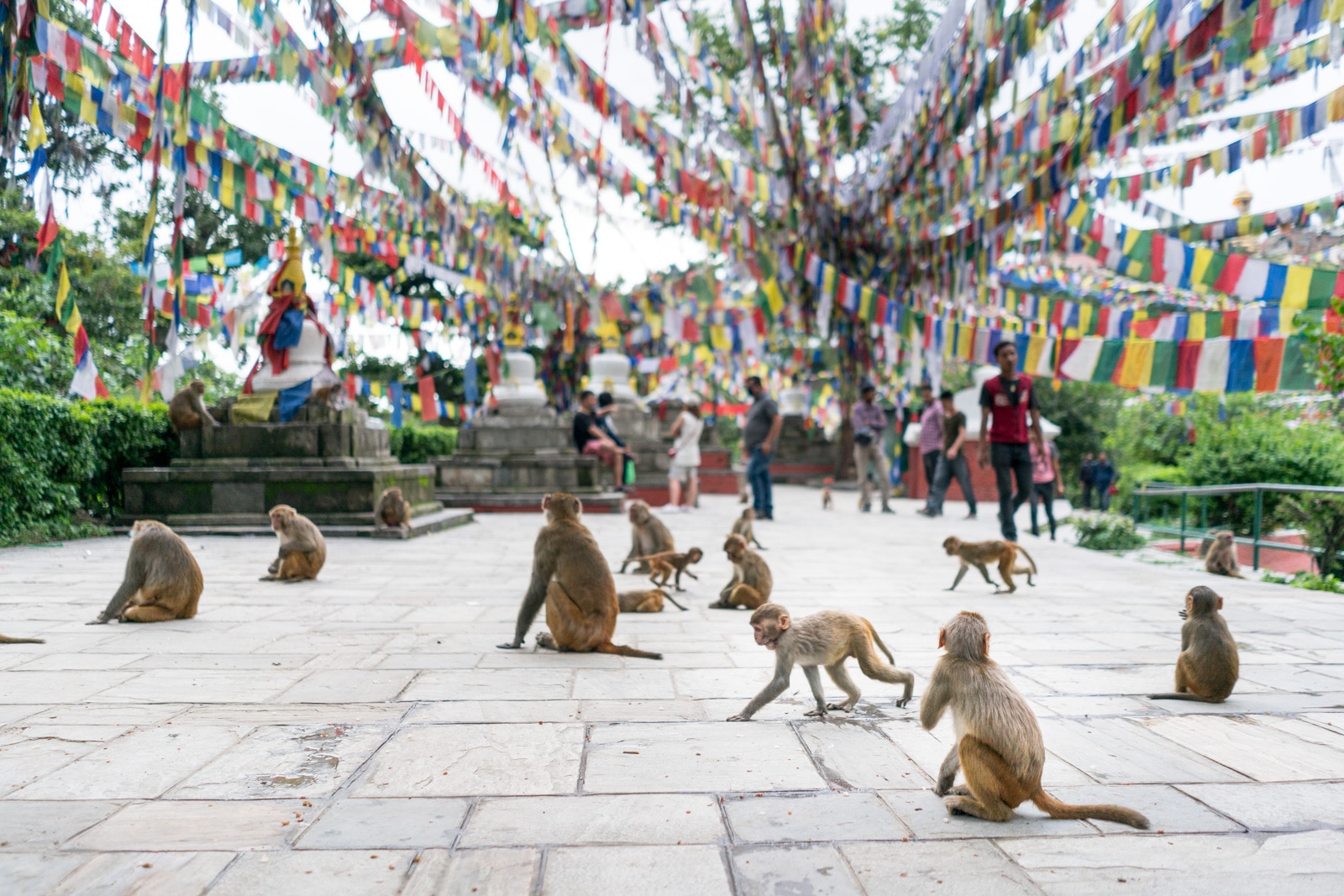
… the Monkey Temple! Hundreds of cheeky rhesus monkeys live amongst the mountaintop stupas. Devious (and sometimes aggressive) as they are, you can’t deny the cuteness as they swing around on the prayer flags and scamper across the stones.
[bscolumns class=”one_third one_third_first”]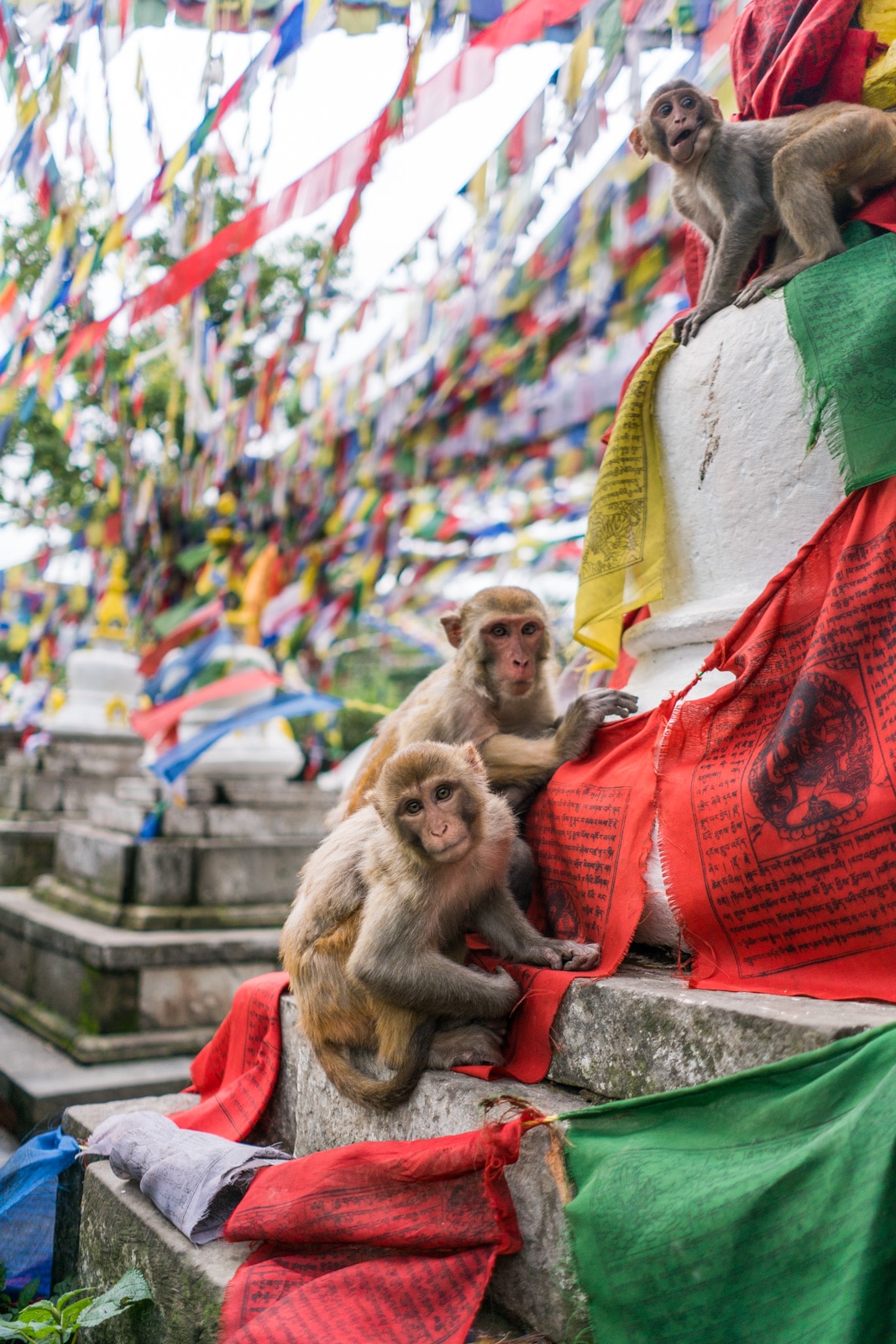

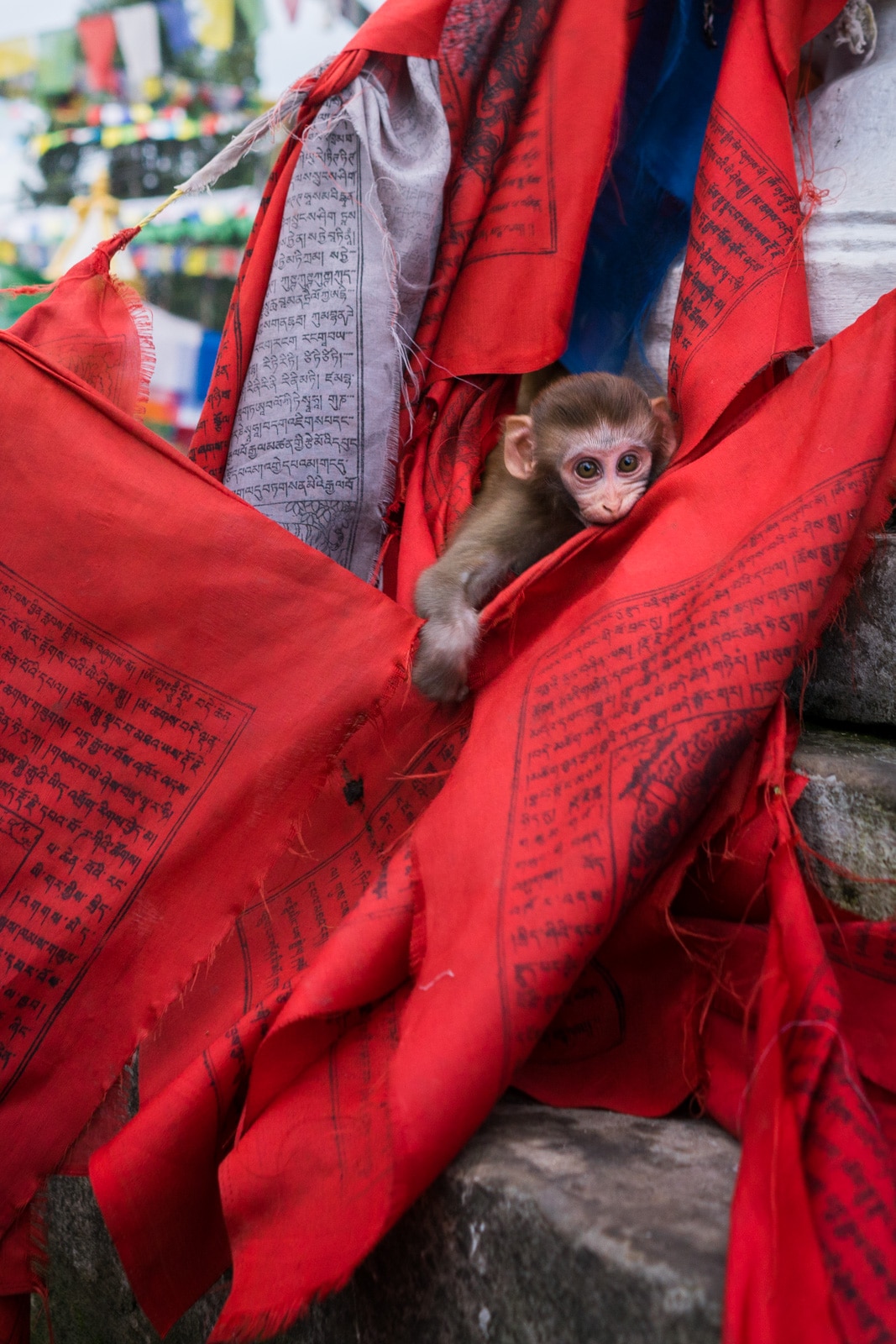

Thug.

We could see the Monkey Temple from our hotel on clear days—see that tiny pointy building atop the hill? Though days were mostly cloudy, we were treated to a couple of nice sunsets while in Kathmandu.

Watching the world go by over cheap—and delicious—coffee from Chikusa Cafe in Thamel, the backpacker area.
[bscolumns class=”one_third one_third_first”]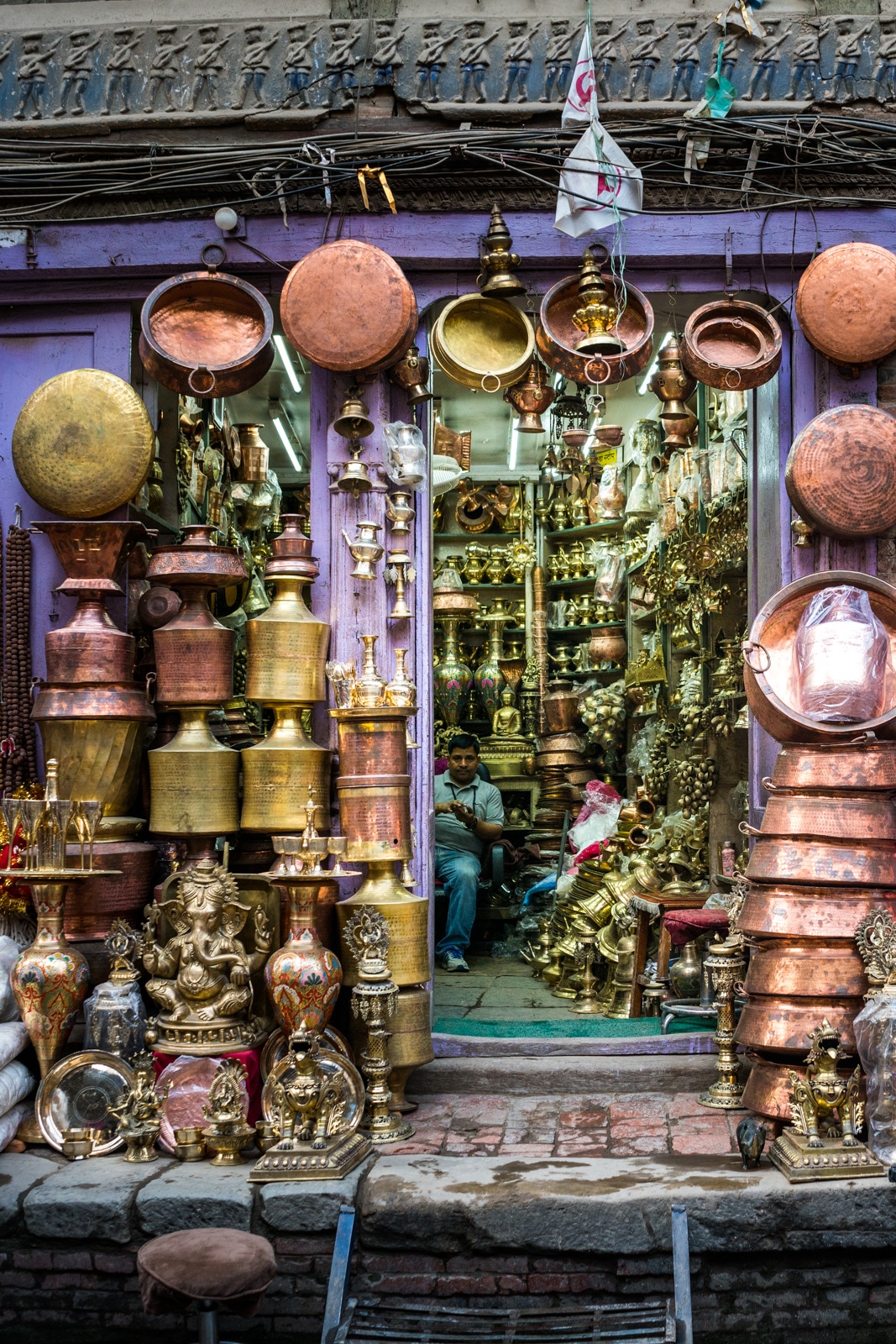
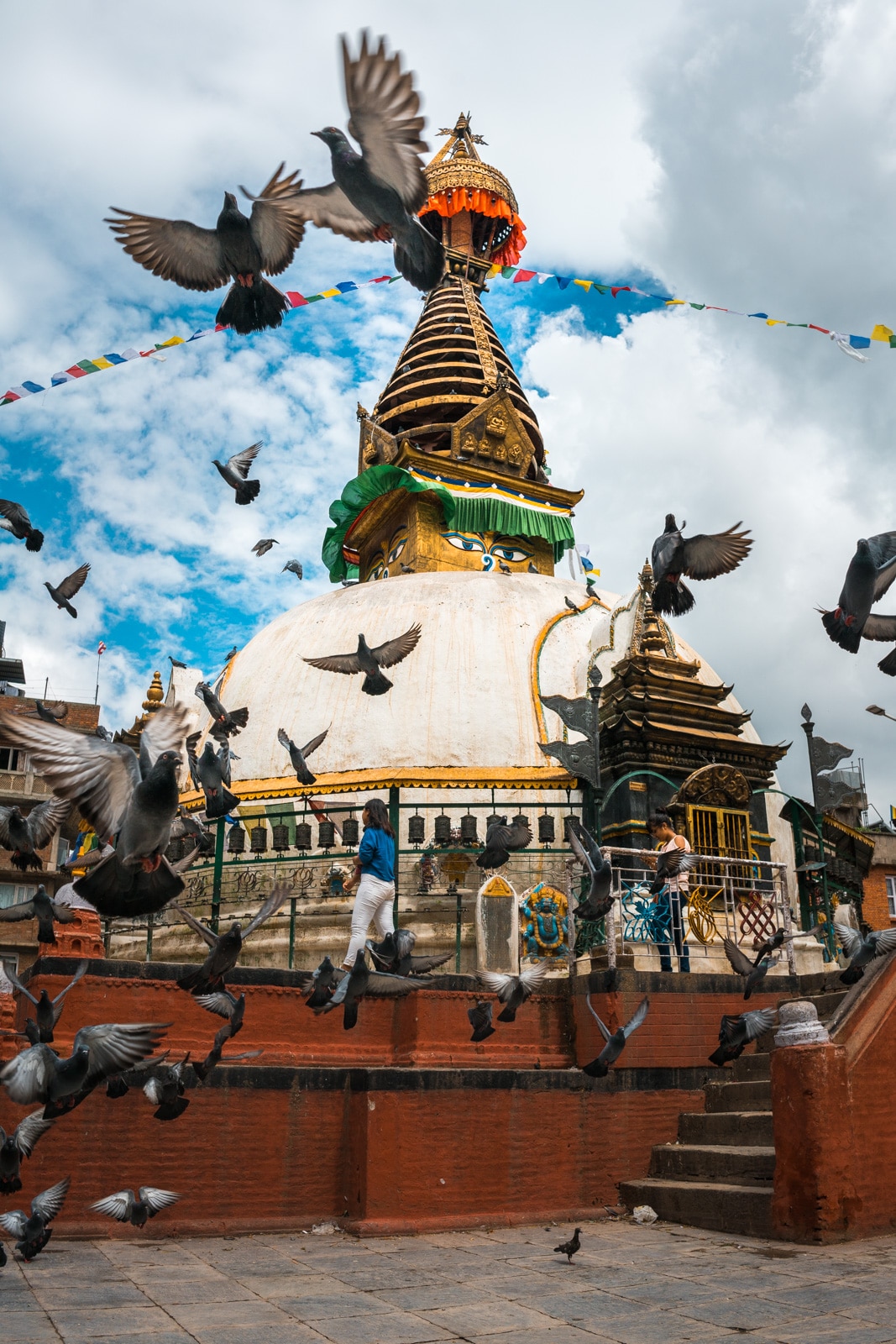

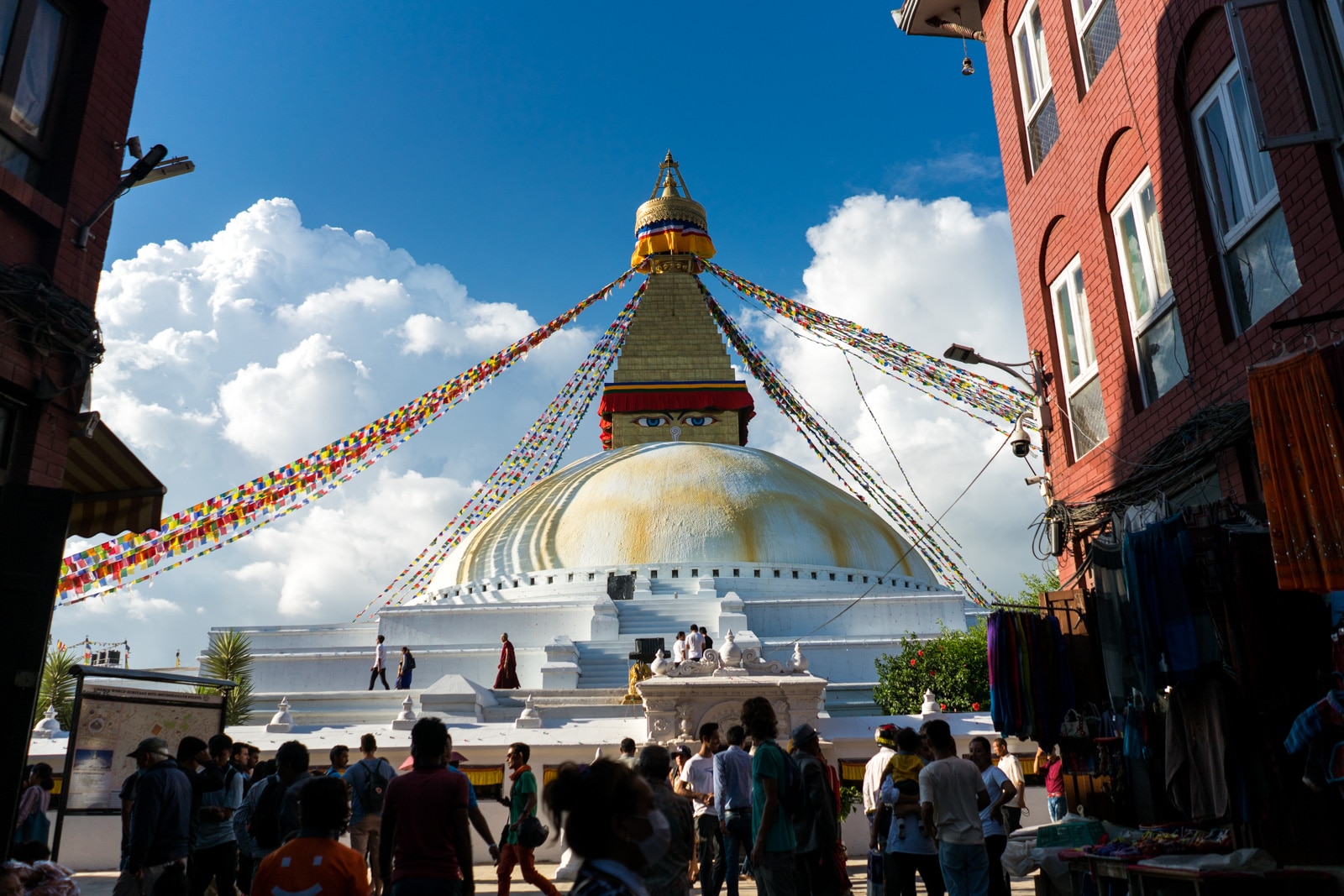
Boudhanath stupa is one of the largest stupas found in Nepal, and a UNESCO World Heritage site. It was one of the last sites we visited, and we were treated to a few hours of clear afternoon skies before the rain kicked in!
[bscolumns class=”one_third one_third_first”]



We arrived on a holiday commemorating the change of the “winds of dharma”. Pilgrims were donating all kinds of food, form popcorn to biscuits to rice. Around sunset, after a bit of fanfare and music, all of the food was redistributed to needy people in the crowds.

Boudhanath stupa suffered massive damage from the 2015 earthquake, but has since been completely rebuilt—the first tourist sight to do so! It’s a powerful sign of Nepal’s ability to stand strong, come together, and rebuild after the catastrophe.
The picture-perfect lanes of Patan
Despite endless the surprises of Kathmandu, we eventually grew tired of Thamel, the backpacker area where we stayed. Strolling through streets of overpriced (and fake) trekking gear, crappy bakeries, and pizza places gets old, thrilling as it may sound.
To shake things up a bit while waiting for our passports to return, we migrated over to Patan, locally known as Lalitpur. Though it’s officially a separate city, you’d be forgiven for thinking it’s just another district of Patan—it’s only 30 minutes’ driving (one hour in traffic) from the center of Kathmandu, and there’s no departure from urban landscapes during said drive.
However, Patan overall felt much more relaxed than Kathmandu. Illogical yet charming alleys wind their way around the old buildings of the city, and there’s a hair less traffic than hectic Kathmandu.
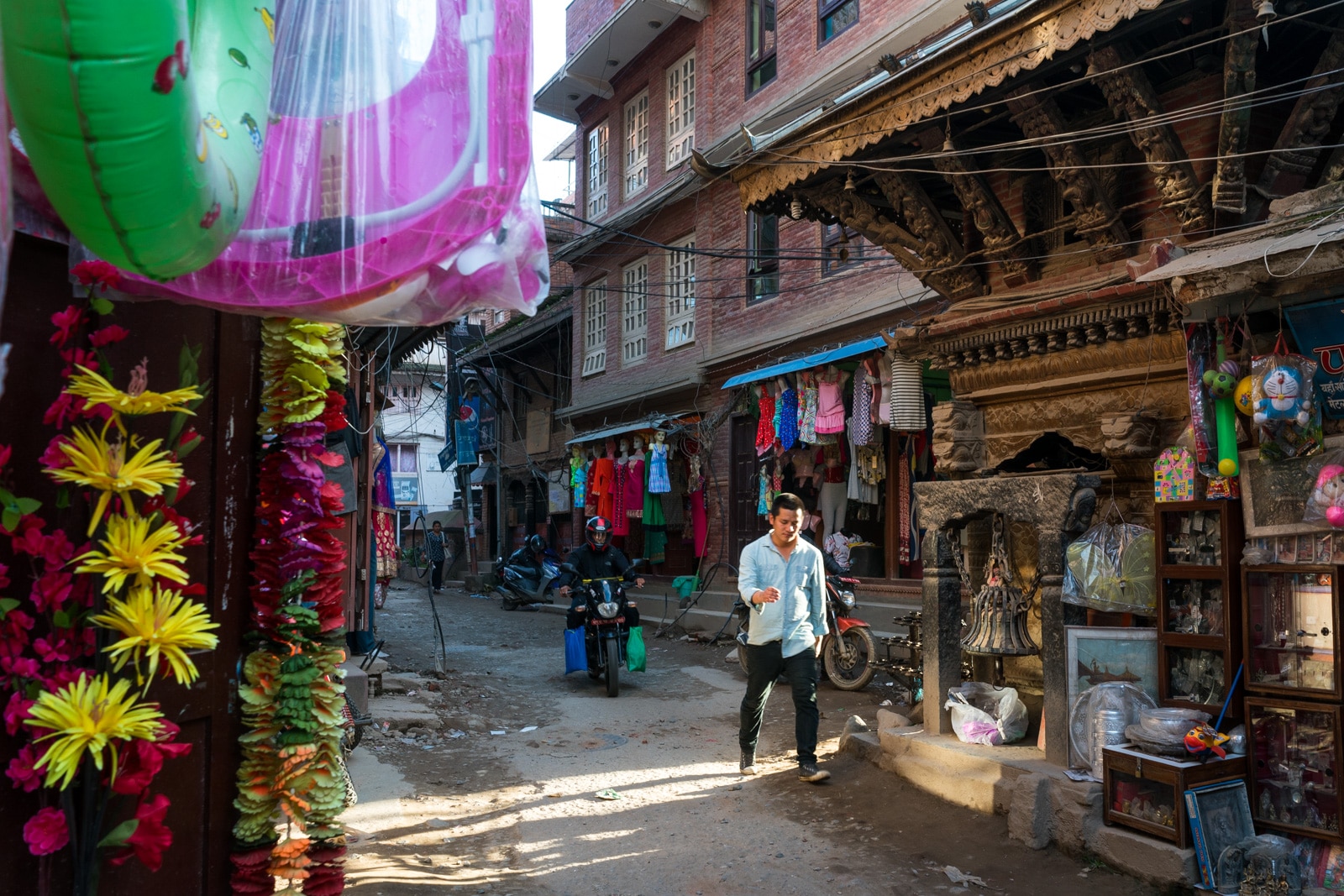
A bit of peace and some good afternoon lighting made us happy campers in Patan! Generally, the days were sunny until the mid to late afternoon, at which the clouds would start rolling in.
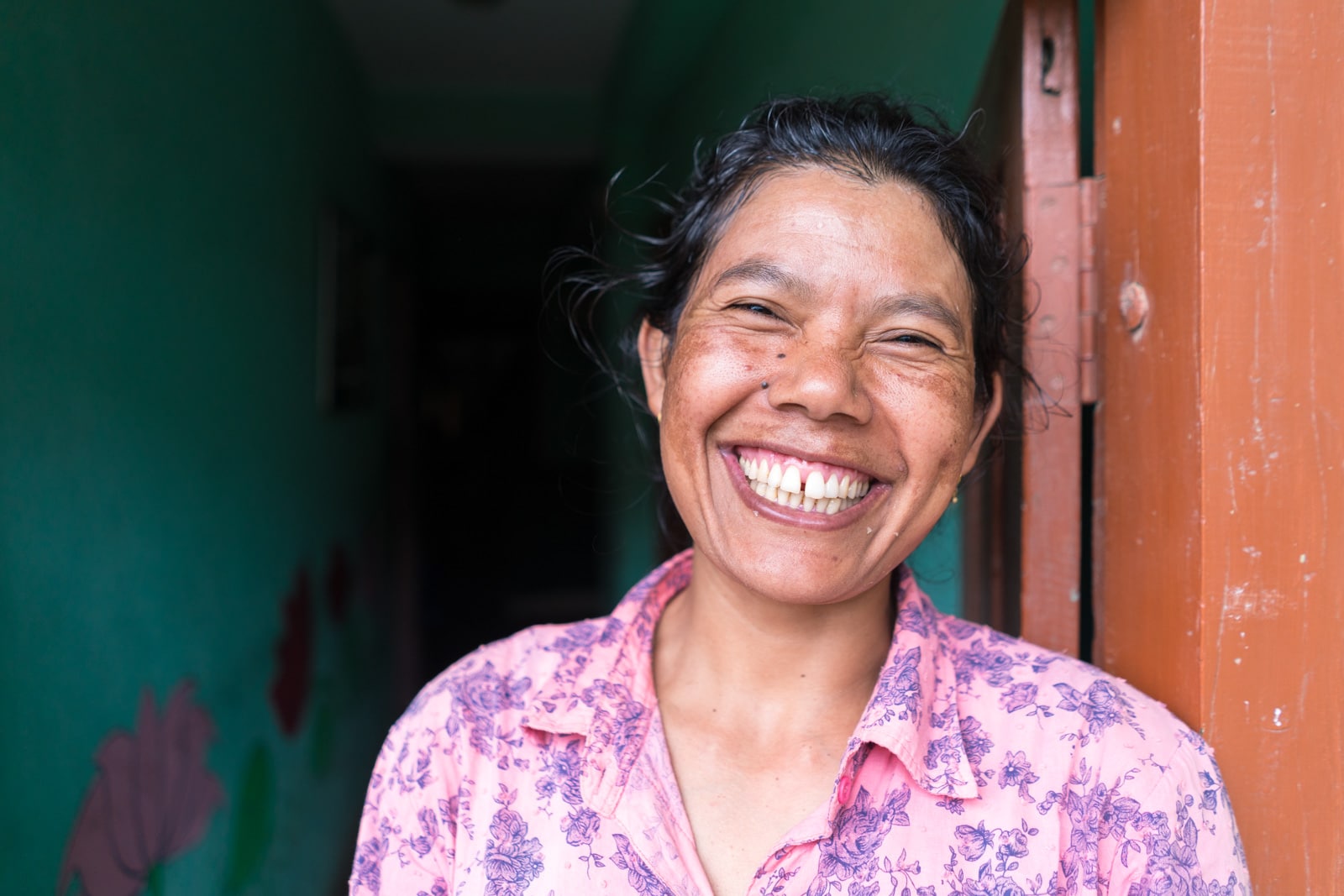
Our stay in Patan was made infinitely better by our lovely homestay host, Sarita. Her blinding smile, endearing personality, and dee-licious vegetarian cooking won’t soon be forgotten! If you’re heading to Nepal, do allot a couple of days to stay at Sanu’s House, her homestay.

I got to tag along with Sarita one cloudy morning as she went out to pick weeds from her family’s nearby rice fields. Yes, you read that right—there are rice paddies to be found within Patan city!

And just for funsies: there’s a massive weed plant growing outside Sarita’s house. A truck driver who often parks near the house proudly proclaimed it was his plant. A work of love!

Aside from Sarita’s charm, another big plus point from Patan is its Durbar Square. Unlike Kathmandu’s Durbar Square, which was horrendously affected by the 2015 earthquake, Patan’s square is relatively intact, and far more atmospheric than its Kathmandu counterpart.
[bscolumns class=”one_third one_third_first”]


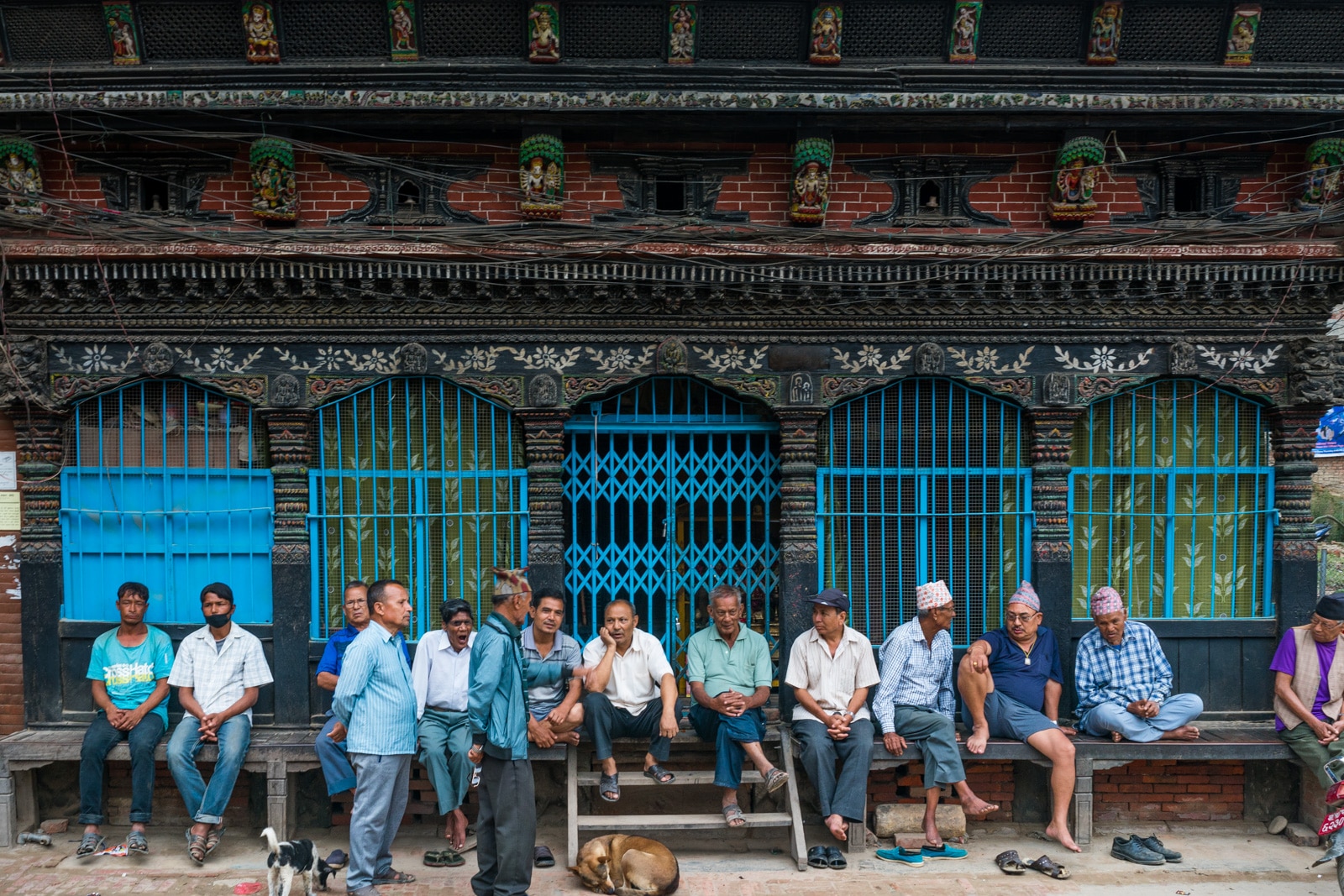
#PatanAndChill
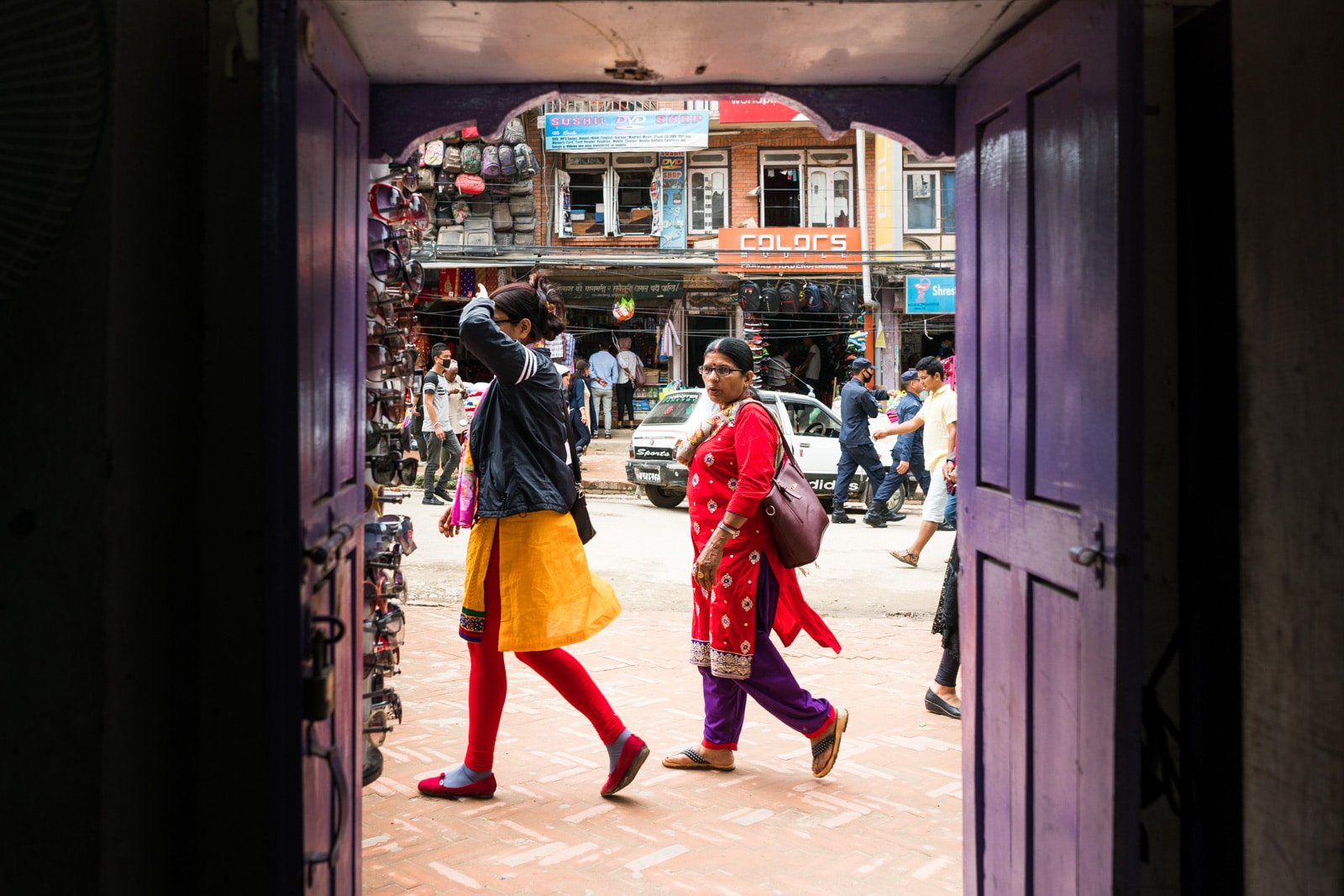
Another photography tip: if the skies above are gray, look to the streets and the people to find splashes of color! Get creative enough, and you won’t find yourself missing blue skies… too much.
[bscolumns class=”one_third one_third_first”]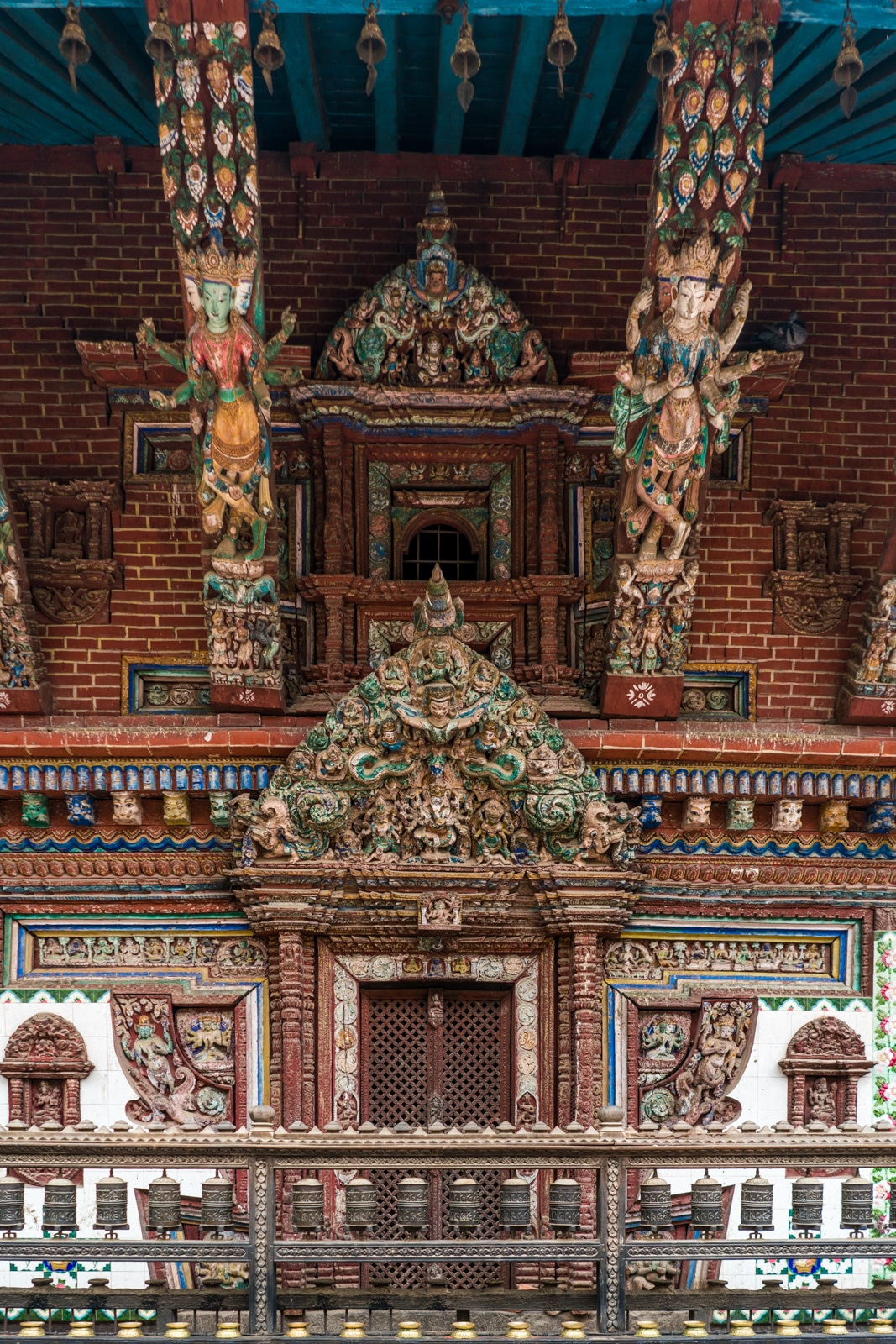



Though Durbar Square gets all the attention, the Hiranyavarna Mahavihara (AKA Golden Temple) was my favorite building in Patan. Virtually unscathed by the earthquake, the Buddhist monastery is hidden in a peaceful little block of Patan, well away from impatient honking and floating dust clouds.

No rush, no hassle—only the sound of quiet chanting and whispering in the background, the perfect soundtrack for taking some time to explore the million and one bedazzled decorations all throughout the monastery.
Still waters and heavy heat in Pokhara
Time passed, the number of days until our Nepal visa expired grew ever smaller, and still our passports were stuck in customs. Wah!
We continued to work during the days, and venture out to explore in the cooler evenings. But, after almost two weeks in Patan, we began to grow restless. Needing yet another change of scenery, we headed to a destination many had raved about: Pokhara, one of the most popular tourist destinations in Nepal.

The quintessential blue boats of Pokhara.

A boy fishing on Phewa Lake, Pokhara’s most famous attraction.
It was a classic case of expectations not meeting reality. People made Pokhara out to seem like a quaint little lakeside town, filled with colorful houses and chill vibes. In reality, the tourist district Pokhara is not much better than Thamel in Kathmandu… perhaps even worse because tourist prices in Pokhara are at least 20% higher than in Kathmandu! (And the wifi is much worse. How is a digital nomad to survive?)
However, most people will visit Pokhara in Nepal, so it’s a great place to make friends and meet trekking buddies.

But on the bright side, we finally got a clear view of snowy mountains! The mountains were usually visible in the early morning, but would be covered with clouds by about 9:00.
The first few days were a letdown. Monsoon in Pokhara means high temperatures (around 35°C) and humidity during the day, and heavy cloud coverage in the evening. It didn’t actually rain particularly hard during the days, but I assure you, there was enough moisture to go around in the air itself.

Eventually, though, we made it to the outskirts of Pokhara, where we were treated to fresh(er) air, gorgeous views, and a significant reduction in signs advertising happy hours and German pastries.

An entirely different world.

The World Peace Pagoda sits atop a small mountain overlooking Pokhara. Clear skies and sunshine warmed us as we began the climb, but at the end of the two hour trek, the entire sky was totally obscured by heavy clouds and rain! Such is monsoon travel in Nepal. (But on the bright side: ominous clouds are sexy.)
So… should I travel in Nepal during monsoon?
If you have the luxury of traveling at a different time, we strongly recommend you try to plan your trip outside of monsoon season. Unless you have a serious cloud or rain fetish, that is.
But, if there’s no other option, you might as well! On the bright side, prices are much lower in the off season, and tourist numbers are cut in half. No need to worry about finding a bed anywhere!
Trekking in Nepal during monsoon
If you’re looking for more information about trekking in Nepal during monsoon, we found these posts helpful (despite not being able to actually apply their advice):
- Best Nepal treks during monsoon
- Nar-phu Valley and Annapurna Circuit in August
- The Annapurna Circuit during monsoon season
Whatever you choose, the best of luck to you, and safe travels!
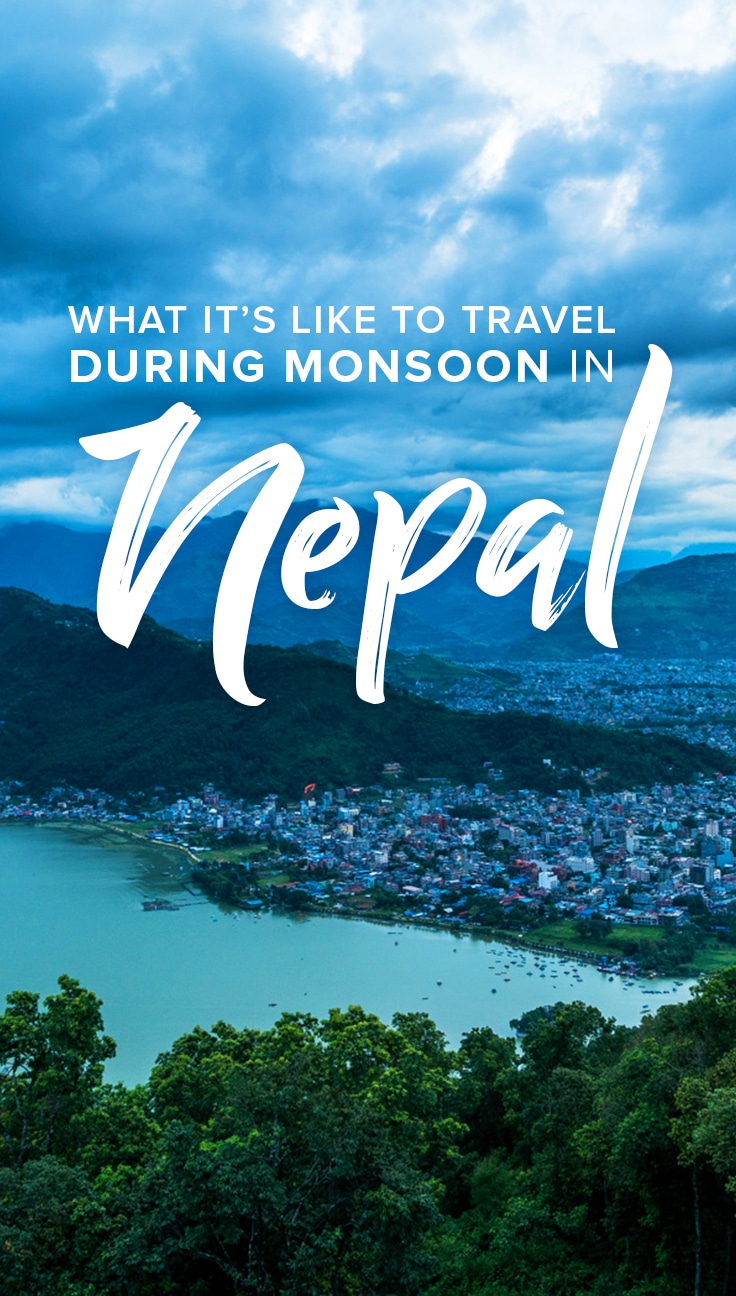
Yay transparency! There are affiliate links in this post. If you buy or book something using our links, we’ll make a wee bit of change at no extra cost to you. Think of it as supporting our blog!



Where did you go to get out of the tourist areas in Pokhara? The photo is beautiful
Thanks for visiting in Nepal, we hope other people also inspire to visit Nepal after seeing your this photo blog. Nice blog. Great information. Nepal is one of the best place to travel with your family. It gives you a lifetime experience.
Will be traveling too during monsoon season argh???? Not a good season, but we’ll try to make the most of it???????????? Thanks for sharing your photos and experiences; I enjoyed reading your article.